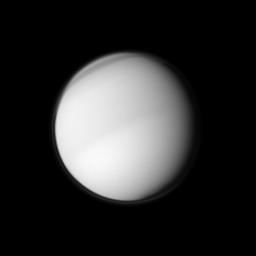Atmospheric Aspects
Caption:
The Cassini spacecraft examines the characteristics of Titan's atmosphere as it peers at Saturn's largest moon using a filter sensitive to visible violet light.
This image shows atmospheric banding around Titan's north pole and reveals hints of the moon's seasonal hemispheric dichotomy near the equator. To learn more about the northern bands, see
PIA08868
and
PIA08928
. See
PIA11603
to learn more about the seasonal dichotomy between the northern and southern hemispheres.
This view looks toward the anti-Saturn side of Titan (5,150 kilometers, or 3,200 miles across). North on Titan is up and rotated 23 degrees to the left.
The image was taken in visible violet light with the Cassini spacecraft wide-angle camera on June 21, 2010. The view was obtained at a distance of approximately 170,000 kilometers (106,000 miles) from Titan and at a sun-Titan-spacecraft, or phase, angle of 33 degrees. Image scale is 10 kilometers (6 miles) per pixel.
Background Info:
The Cassini-Huygens mission is a cooperative project of NASA, the European Space Agency and the Italian Space Agency. The Jet Propulsion Laboratory, a division of the California Institute of Technology in Pasadena, manages the mission for NASA's Science Mission Directorate, Washington, D.C. The Cassini orbiter and its two onboard cameras were designed, developed and assembled at JPL. The imaging operations center is based at the Space Science Institute in Boulder, Colo.
For more information about the Cassini-Huygens mission visit
http://saturn.jpl.nasa.gov/
. The Cassini imaging team homepage is at
http://ciclops.org
.
Cataloging Keywords:
| Name |
Value |
Additional Values |
| Target |
Titan |
Saturn |
| System |
Saturn |
|
| Target Type |
Satellite |
Planet |
| Mission |
Cassini-Huygens |
|
| Instrument Host |
Cassini Orbiter |
|
| Host Type |
Orbiter |
|
| Instrument |
Imaging Science Subsystem (ISS) |
|
| Detector |
Wide Angle Camera |
|
| Extra Keywords |
Atmosphere, Grayscale, Rotation, Visual |
| Acquisition Date |
|
| Release Date |
2010-08-10 |
| Date in Caption |
2010-06-21 |
|
| Image Credit |
NASA/JPL/Space Science Institute |
| Source |
photojournal.jpl.nasa.gov/catalog/PIA12695 |
| Identifier |
PIA12695 |

 Planetary Data System
Planetary Data System
